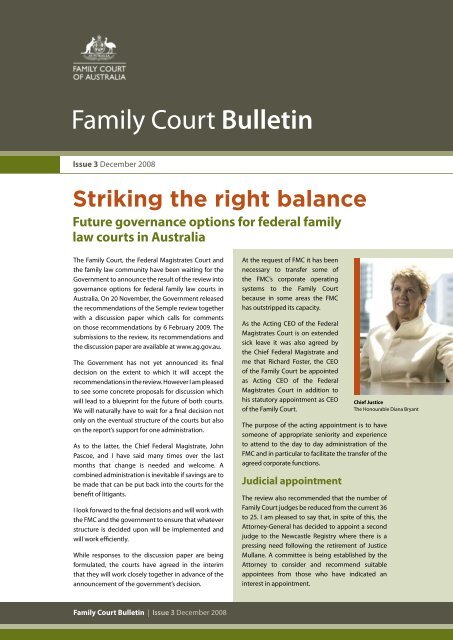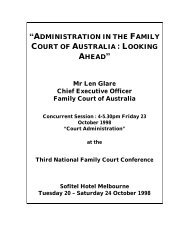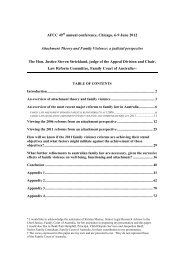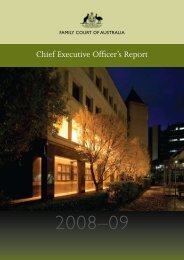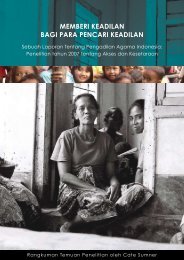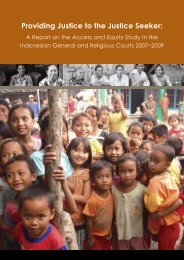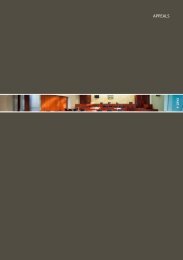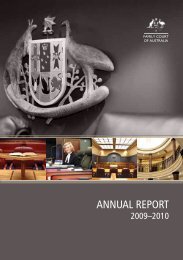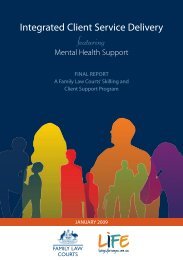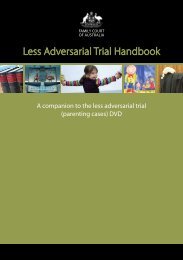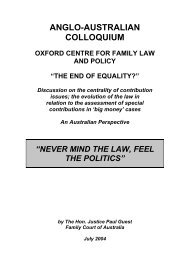Open PDF - Family Court Bulletin - December 2008 - Size 366 KB
Open PDF - Family Court Bulletin - December 2008 - Size 366 KB
Open PDF - Family Court Bulletin - December 2008 - Size 366 KB
- No tags were found...
You also want an ePaper? Increase the reach of your titles
YUMPU automatically turns print PDFs into web optimized ePapers that Google loves.
LGM and CAM—Contempt continued…He ordered that two months of each term be servedconcurrently.The judge also ordered that the wife pay the husband’scosts of the contempt proceedings on an indemnitybasis. The judge found that “the wife had been complicitin an attempted fraud that was designed to move thewhole matrimonial pool out of reach of the husbandand <strong>Family</strong> <strong>Court</strong>” and that it was deliberate and premeditated.The wife appealed the judgment of 2004 which foundthat she had committed contempt of court and thejudgment of 2005 which imposed the penalty of a termof imprisonment. The judge who had made these ordersgranted a stay of the orders pending the Full <strong>Court</strong>hearing and decision. He wanted to avoid the possibilitythat the wife would be imprisoned unnecessarilywhile waiting for the Full <strong>Court</strong> to determine whethercontempts were committed and what the appropriatepenalty should be.The Full <strong>Court</strong> heard the appeal in September 2005 andfound that the wife’s appeal should succeed. It deliveredits judgment on 25 August 2006 which set aside thecontempt order and therefore her prison sentence. Thehusband then appealed to the High <strong>Court</strong> and requestedthat it look at the issue of whether or not contempt ofcourt had occurred on the part of the wife.In May 2007, the High <strong>Court</strong> (Gleeson CJ, Hayne, Callinan,Heydon and Brennan JJ) ordered that the appeal againstpart of the judgment of the Full <strong>Court</strong> of 25 August2006 be allowed and that the matter be remitted to adifferently constituted Full <strong>Court</strong> of the <strong>Family</strong> <strong>Court</strong>.It ordered that the wife pay the husband’s costs of theappeal to the High <strong>Court</strong> but that the issue of who shouldpay the costs of the Full <strong>Court</strong> proceedings up to andincluding the order of 25 August 2006 be determined bythe Full <strong>Court</strong> when it reheard the case.the wife was to serve a period of imprisonment of fourmonths which she did commencing on 14 January <strong>2008</strong>.The order that the wife pay the husband’s costs onan indemnity basis was set aside. However, the Full<strong>Court</strong> made orders that the wife pay 85 per cent of thehusband’s costs relating to the appeal proceedingsdetermined in January <strong>2008</strong> (establishing contemptand the penalty) and 85 per cent of the husband’s costsrelating to the appeal proceedings determined in August2006 (the September 2005 hearing in the Full <strong>Court</strong>) ona party–party basis.So far, this case has generated 18 first instancejudgments, seven Full <strong>Court</strong> judgments, a High <strong>Court</strong>judgment, a Federal Magistrates’ <strong>Court</strong> judgment and atleast 18 judges have been involved in some way in theproceedings. It has been over 10 years since the partiesfirst filed applications for a property settlement. Theorder made in 1999 restraining the wife from dealing inreal estate which was part of the assets of the marriagehas come to dominate the case with claims, counterclaimsand multiple appeals. The dominance has madeit easy to forget that the underlying property mattersare yet to be concluded. It is worth noting that duringthe period 1997–2007, there was also concurrent legalaction in the NSW Supreme <strong>Court</strong>, the <strong>Family</strong> <strong>Court</strong> andthe Federal Magistrates <strong>Court</strong> related to the parties’business interests which impacted on their family lawproperty matters.The Full <strong>Court</strong> reheard the appeal in October 2007 andhanded down its decision on 10 January <strong>2008</strong> thatcontempts of court had been committed. Therefore<strong>Family</strong> <strong>Court</strong> <strong>Bulletin</strong> | Issue 3 <strong>December</strong> <strong>2008</strong> 3
Initiatives and Programs<strong>Family</strong> Law Amendment (De Facto Financial Matters & Other Measures) Bill <strong>2008</strong>BackgroundOn 10 November <strong>2008</strong> the government passed the<strong>Family</strong> Law Amendment (De Facto Financial Matters andOther Measures) Bill <strong>2008</strong>. The primary impact of this newlegislation will be to bring financial disputes arising outof the breakdown of de facto relationships (of same andopposite sex) under the <strong>Family</strong> Law Act. As a consequence,when this Bill commences, de facto couples will haveaccess to courts exercising federal family law jurisdiction(e.g. <strong>Family</strong> <strong>Court</strong> of Australia and Federal Magistrates<strong>Court</strong> of Australia) in property and maintenance matters.Under current law, while de facto couples can apply tocourts exercising federal jurisdiction under the <strong>Family</strong>Law Act regarding parenting matters, they can onlyapply to State or Territory courts under State or Territorylaws regarding property and financial matters. A furthercomplication is that laws differ between the variousStates and Territories.The Bill will also make other amendments to the <strong>Family</strong>Law Act in relation to financial agreements betweenmarried couples, superannuation splitting and familydispute resolution certificates.The Bill relies on referrals of power by States to theCommonwealth. At present, Tasmania, Victoria, NewSouth Wales and Queensland have referred the relevantpowers. Therefore residents in those States and in the twoTerritories will be covered by the provisions of the Bill.What is a de facto relationship?For a court exercising federal family law jurisdictionto hear an application for property settlement ormaintenance between de facto partners, the court mustbe satisfied of all of the following:zx that the relationship is a genuine de factorelationship, and not merely a dependent domesticrelationship, andzx that the parties have a geographic connection to aparticipating jurisdiction, i.e. to a State which hasreferred power or to a Territory, andzx that the parties’ relationship broke down after thecommencement of the Bill, or that both parties haveconsented, after receiving legal advice, to the matterbeing determined in accordance with the new laws,despite the fact that the relationship broke downbefore the Bill commenced —‘opting in’.The circumstances to be considered when determiningwhether the couple is in a de facto relationship are:1.2.3.the duration of the relationshipthe nature and extent of their common residencewhether a sexual relationship exists4. the degree of financial dependence orinterdependence and any arrangements forfinancial support between them5.6.7.8.9.the ownership, use and acquisition of their propertythe degree of mutual commitment to a shared lifewhether the relationship is or was registered in aState or Territory that has a relationship registerthe care and support of childrenthe reputation and public aspects of the relationship.No particular finding in relation to any of the abovecircumstances is necessary, but the list is intended as aguide to what may constitute a de facto relationship.In addition to establishing that a de facto relationshipexists, a court needs to be satisfied that at least one ofthe following four ‘gateway requirements’ has been met:zx that the period, or total of the periods, of the defacto relationship, is at least two years, orzx that there is a child of the relationship, orzx that the applicant made substantial contributions tothe parties’ property or as a homemaker or parentand that failure to make an order or declarationwould result in serious injustice to the applicant, orzx that the relationship was registered under the law ofa State or Territory.4<strong>Family</strong> <strong>Court</strong> <strong>Bulletin</strong> | Issue 3 <strong>December</strong> <strong>2008</strong>
It should be noted that mere registration of a relationshipdoes not of itself establish that the relationship is to becategorised as a de facto relationship for the purposesof the <strong>Family</strong> Law Act. Registration is significant,but nevertheless it is just one of the factors to beconsidered.The definition of a de facto relationship includes arelationship in which one party is legally married tosomeone other than their de facto partner or where oneparty is simultaneously in another de facto relationship.MaintenanceThe Bill provides that once a court is satisfied that ade facto relationship has been established as outlinedabove, the court may order a party to the relationshipto pay maintenance to their former de facto partneror partners.In addition, the Bill enables a court to vary any orderto maintain a former marriage partner or de factopartner on grounds including that the person receivingmaintenance has subsequently entered a stable andcontinuing de facto relationship.The Bill also provides that an order to maintain aformer de facto partner ceases to have effect once theparty receiving maintenance marries, unless in specialcircumstances a court orders otherwise. A similarprovision is already contained in the <strong>Family</strong> Law Actin relation to orders to maintain a former marriagepartner.Financial mattersParties to a de facto relationship can make a financialapplication to a court (including for division of propertyor maintenance for a partner) provided that theapplication is brought within two years of the end ofthe relationship. A party may apply for an extension ofthis time limit on the basis that hardship for the party ora child would be caused or, in relation to maintenance,when the party’s circumstances at the end of thestandard application period were such that the partywas unable to support him or her self without an incometested benefit.The new laws also permit de facto couples to enterinto financial agreements before, during or after theirrelationship which are binding upon the parties to theagreement. These agreements will exclude the courts’jurisdiction under the <strong>Family</strong> Law Act in relation to thematters covered in the agreement in the same waythat married couples are currently able to exclude thejurisdiction of the courts.The Bill introduces a new ground for setting aside financialagreements where a person has attempted to defraudor defeat a claim of their de facto partner or spousethrough a ‘sweetheart deal’ with another de facto partneror spouse.A financial agreement that has been validly entered intobefore the commencement of the Bill under the laws of aState or Territory will be recognised as binding under the<strong>Family</strong> Law Act if the agreement:zx deals with the distribution of property or financialresources, maintenance or incidental matters,zx is validly made under the State or Territory law suchthat a State or Territory court could not make an orderinconsistent with the terms of the agreement.In financial proceedings between de facto partners ormarriage partners, courts will be required to take intoaccount the terms of any financial agreement that isbinding on either of the parties (for example a financialagreement that one of the parties has made with theircurrent or former de facto or marriage partner).If a de facto relationship breaks down and financialproceedings are instituted in a court but one party thendies before the proceedings are finalised, the court willhave jurisdiction to finalise the proceedings.SuperannuationThe new laws will allow de facto couples to split theirsuperannuation interests as part of their financialsettlement. Superannuation will be treated as property, as itis currently for married couples. A superannuation split canbe achieved by court order or by making a superannuationagreement as part of a financial agreement which isbinding on the parties to the agreement.Note: The <strong>Family</strong> Law (De Facto Financial Matters and Other Measures) Bill <strong>2008</strong> received Royal Assent on 21 November <strong>2008</strong>. While the substantive de facto financial mattersprovisions are to commence on a day to be proclaimed or 6 months from the Royal Assent, whichever is earlier, there are a number of other amendments to the <strong>Family</strong> Law Act 1975which commenced from the date of the Royal Assent, namely 21 November <strong>2008</strong>.<strong>Family</strong> <strong>Court</strong> <strong>Bulletin</strong> | Issue 3 <strong>December</strong> <strong>2008</strong> 5
Commonwealth <strong>Court</strong>sPortaleFiling commences in <strong>Family</strong> Law <strong>Court</strong>sPhase one of electronic filing (eFiling) commenced on16 August <strong>2008</strong>. It is now possible for lawyers to filesupplementary documents in family law matters via theCommonwealth <strong>Court</strong>s Portal (www.comcourts.gov.au).This means that lawyers and law firms who havefamily law matters with the <strong>Family</strong> <strong>Court</strong>, the FederalMagistrates <strong>Court</strong> or the <strong>Family</strong> <strong>Court</strong> of WesternAustralia—and are registered with the Portal —can filesupplementary documents in family law matters in doc,rtf or <strong>PDF</strong> formats.Supplementary documents mean any document lodgedagainst an existing cause of action that does not attracta fee and does not require follow up action by court staffonce lodged.Documents which can be electronically filed in the<strong>Family</strong> <strong>Court</strong> of Australia include:zx Affidavits *zx Financial Statementszx Service Documents *zx Notice to Admit Factszx Undertaking as to Disclosurezx Case management documents—summariesof argument, outline of case documents, list ofdocuments etc.Phase two of eFiling, which is scheduled for release in2009, will further expand the service and offer eFilingto self represented clients as well as the ability to fileinitiating applications online.Questions and Answers about eFiling in the<strong>Family</strong> Law <strong>Court</strong>sIs electronic filing mandatory?No. It is not mandatory at this stage. It is an option forthe convenience of family law firms and will enable thecourts to make operational efficiencies over time.* Sworn documents can be filed electronically in accordance with <strong>Family</strong> Law Rules 24.07.Documents which can be electronically filed in theFederal Magistrates <strong>Court</strong> include:zx Response to Divorcezx Affidavit of Service (of any description)zx Financial Statementzx Affidavit #zx Superannuation Information Formzx Outline of case document, as described, if directed tobe filed.# An affidavit can be electronically filed only by sending a scanned image of theaffidavit (and annexures to it) which must be signed and witnessed in accordancewith the Federal Magistrates <strong>Court</strong> Rules. If directed by the <strong>Court</strong> at any stage, thesender may need to produce the original Affidavit to the <strong>Court</strong> (see Rule 2.07(8)(b)(ii))Who can eFile supplementary documents?At this stage, only law firms which are Portal registrants.What is the definition of a supplementary document?A supplementary document means any documentlodged against an existing cause of action that does notattract a fee and does not require follow up action bycourt staff once lodged.What compliance checking do registries need toapply to documents filed through the Portal?We do not compliance check documents filed by law firmsover the counter and we will not require any checkingover and above that standard for eFiled documents.6<strong>Family</strong> <strong>Court</strong> <strong>Bulletin</strong> | Issue 3 <strong>December</strong> <strong>2008</strong>
<strong>Family</strong> Law <strong>Court</strong> staff provideddemonstrations of the portal throughoutthe <strong>Family</strong> Law Residential in August <strong>2008</strong>Do the Statutes and Rules allow for electronic filing?The <strong>Family</strong> Law Rules 2004 do envisage electronic filing(for example Rule 24.07). Any remaining issues arising inthe <strong>Family</strong> Law Rules and those questions which arisefrom the Federal Magistrates <strong>Court</strong> Act and Rules arepresently being considered by the <strong>Court</strong>s’ respectiveRules and Legal Committees. In the meantime, registriesare required to print and mark documents filed via thePortal each day in order to ensure legal compliance.How will the party filing the document know that ithas been filed successfully?The filing party will receive an electronic receipt ofconfirmation.In an electronic environment, what time is the endtime for the purposes of filing ‘within time’?As is the case now, to file in time, a party must file by4.30pm of the final day.When will eFiling of initiating applications beallowed and when will eFiling be an option forself represented clients?Phase 2 of eFiling will not commence before 2009. Thisincludes electronic filing of initiating applications andthe option of Portal registration for self representedclients.Queensland family law practitionerslook forward to eFilingThe Commonwealth <strong>Court</strong>s Portal exhibition created a lotof interest at the 23rd Annual Calabro Consulting <strong>Family</strong>Law Residential on the Gold Coast in August.The conference was attended by more than 450Queensland family law practitioners and interestedstakeholders, including <strong>Family</strong> <strong>Court</strong> staff.The Portal exhibit was a great opportunity to promote anddemonstrate electronic filing of supplementary documents(eFiling Stage 1), the latest application on the Portal, to ahighly targeted group of family law practitioners.‘The exhibit and concept of eFiling received a positiveand enthusiastic response from the QLD family lawpractitioners. In particular, family law practitioners fromremote areas in QLD are looking forward to the time savingpossibilities of filing documents online,’ said StephenAndrew, Executive Director Information, Communication& Technology Services, <strong>Family</strong> <strong>Court</strong> of Australia.The 23rd Annual Calabro Consulting <strong>Family</strong> Law Residentialprovided an overview of developments in family law overthe past 12 months. Speeches were delivered by leadinglocal and interstate practitioners, members of the bar andjudiciary, politicians and social scientists including theAttorney-General Robert McClelland MP and Chief JusticeBryant, <strong>Family</strong> <strong>Court</strong>.NEW: videos for Commonwealth <strong>Court</strong>s PortalThree new instructional and promotional videos for the Commonwealth<strong>Court</strong>s Portal are now available:zx Introduction to the Commonwealth <strong>Court</strong>s Portalzx Guide to the Commonwealth <strong>Court</strong>s Portal for Legal Practitionerszx Guide to the Commonwealth <strong>Court</strong>s Portal for AdministratorsThe videos can be accessed at www.comcourts.gov.au<strong>Family</strong> <strong>Court</strong> <strong>Bulletin</strong> | Issue 3 <strong>December</strong> <strong>2008</strong> 7
Operations Manager, Julie Greig,received the award on behalf ofboth courtsMental Health Support Program wins silverThe <strong>Family</strong> Law <strong>Court</strong>s won a silver award for the MentalHealth Support Program in the <strong>2008</strong> Australia and NewZealand Mental Health Service Achievement Awards.The Mental Health Service Achievement Award programbegan in 1992 and was designed to reward and publiciseservices that have shown innovation and excellence.The awards are made possible through grants fromthe Australian Government Department of Health andAgeing and The New Zealand Health Funding Authority.The courts were notified in June <strong>2008</strong> that their entry inthe category ‘Mental Health Promotion or Mental HealthAwareness’ had been selected as a finalist.The awards were announced on 3 September <strong>2008</strong> duringthe Mental Health Services Conference of Australia andNew Zealand in Auckland, New Zealand.Origins of the Mental Health Support ProgramIn October 2004 the <strong>Family</strong> Law <strong>Court</strong>s submitted aproposal to the Australian Government Departmentof Health and Ageing to obtain funding under theNational Suicide Prevention Strategy.The proposal covered a variety of approaches tosupport suicide prevention and the emotionalwellbeing of clients. These ranged from a researchcomponent to identifying points of stress within theprocedures of the court to preventative and reactiveclient interventions.The proposal acknowledged the need for alignmentwith the guiding principles of the Living Is ForEveryone (LIFE) framework, which states that suicideprevention initiatives must be evidence-based,outcome-focused and must incorporate expertinput.The proposal was accepted and a Memorandum ofAgreement (MOA) was signed between the <strong>Family</strong><strong>Court</strong> of Australia and the Australian GovernmentDepartment of Health and Ageing.In 2005–06, with the support of the National SuicidePrevention Strategy and the Australian GovernmentDepartment of Health and Ageing, the <strong>Family</strong> Law<strong>Court</strong>s piloted the Mental Health Support Program inSouth Australia and the Northern Territory.An independent evaluation revealed positive resultsfor both clients and staff which led to a nationalrollout of the Mental Health Support Program withinthe <strong>Family</strong> Law <strong>Court</strong>s.Key program featuresThe Mental Health Support Program is designed tohelp clients who are suffering the effects of separationand divorce on their emotional wellbeing.The program is based on three key elements:zx a mental health support training program forall staffzx the implementation of a set of protocols to helpstaff manage clients presenting with mentalhealth issues from stress to imminent threat ofharm to self or others andzx the development of a network of communitybasedorganisations able to provide support toclients in need.While the <strong>Family</strong> Law <strong>Court</strong>s do not have a directrole in providing mental health services to clients, itis acknowledged that they do have a facilitating role,and that is to ensure, where possible, that clients areable to access mental health services provided byexternal organisations.8<strong>Family</strong> <strong>Court</strong> <strong>Bulletin</strong> | Issue 3 <strong>December</strong> <strong>2008</strong>
One year on: tell us whatyou thinkIs the <strong>Family</strong> <strong>Court</strong> <strong>Bulletin</strong> meetingyour needs?The <strong>Family</strong> <strong>Court</strong> <strong>Bulletin</strong> has been developed to keeplegal practitioners, parliamentarians and other keystakeholders up to date with the work and workingsof the <strong>Family</strong> <strong>Court</strong> of Australia.It intends to inform about the trends in family law,the work of the <strong>Court</strong>, new programs and initiatives,judicial and executive appointments and retirementsas well as jurisprudentially interesting judgements.New: Child ResponsiveProgram brochureA new brochure Child Responsive Program is nowavailable to order or download from the <strong>Family</strong><strong>Court</strong> website at www.familycourt.gov.auThis brochure gives parents and carers informationabout the Child Responsive Program in the <strong>Family</strong><strong>Court</strong>. The Child Responsive Program involves aseries of meetings between a family consultant,the parents (or other carers), and the children. Themeetings focus on the children’s needs and theaim is to assist parents and the <strong>Court</strong> to achieve thebest outcomes for the children.It has been a year since the first issue was released,and we would like you to tell us what you think of it.Please email any suggestions, comments or feedbackto communications.office@familycourt.gov.au<strong>Family</strong> <strong>Court</strong> of Australia Annual Report 2007–08The <strong>Family</strong> <strong>Court</strong>’s 2007–08 Annual Report wastabled in Parliament on 20 October <strong>2008</strong>.The Chief Justice’s year in review highlighted majorchanges and initiatives for 2007–08 including:zx Commonwealth <strong>Court</strong>s Portal and eFilingzx Judicial hearing docketzx Less Adversarial Trialzx Child Responsive Programzx Magellanzx Integrated Client Service Delivery Programzx Providing Justice to the Justice Seeker, andzx Young Employees Advisory Group.The outstanding design, layout and printing ofthis year’s Annual Report has been recognisedby professionals in the printing industry andwas entered in the Print and Graphic Excellence(PAGE) Awards annual report section for <strong>2008</strong>.Copies of the report are available from the:zx <strong>Family</strong> <strong>Court</strong> website www.familycourt.gov.au orzx communications.office@familycourt.gov.au<strong>Family</strong> <strong>Court</strong> <strong>Bulletin</strong> | Issue 3 <strong>December</strong> <strong>2008</strong> 9
Australia and Indonesia sign judicial cooperation MOUThe first signing of a formal agreement for Asian andIndonesian courts with the Asian Legal InformationInstitute (AsianLII) for it to provide free online access toIndonesian court decisions on www.asianlii.org wassigned in Melbourne in July <strong>2008</strong>. This formed part ofthe inaugural trilateral Memorandum of Understanding(MOU) hosted by Chief Justice Bryant.Professor Grahame Greenleaf of AsianLII and Dr BagirManan, Chief Justice of the Supreme <strong>Court</strong> of Indonesia,said that this was a logical next step, following lastFebruary’s launch of an online database of High Religious<strong>Court</strong> decisions, to increase judicial transparency.‘These new online facilities will ensure that Indonesiancourt decisions from both the Religious and generaljurisdictions will now be freely accessible to the public inIndonesia and around the world,’ Chief Justice Bryant said.‘This will be an important contribution to Indonesia’scontinuing judicial reform process.’The trilateral MOU that was signed by the heads ofjurisdiction, including the Chief Justice of the Supreme<strong>Court</strong> of Indonesia, creates a framework for the courtsto work together to promote further understandingof each other’s laws and judicial cultures. Chief JusticeBryant said ‘Through the MOU the courts will be able toassist each other to develop and implement commoninternational legal standards.‘Australia now has new opportunities to help support theadministration of justice in Indonesia and the capacityof the Supreme <strong>Court</strong> of the Republic of Indonesia tomanage its responsibility for more than 30 000 judgesand court staff is enhanced by the MOU.’The Indonesian delegation’s visit was supported by theIndonesia Australia Legal Development Facility, a jointIndonesian and Australian initiative, based in Jakartaand funded by AusAID. Its aims are to strengthen thecapacity of the Indonesian government and civil societyto promote legal reform as well as protect human rights.AppointmentsJustice Stephen O’RyanJustice Stephen O’Ryan of the Sydney Registry was assigned to the Appeal Division of the <strong>Family</strong> <strong>Court</strong> of Australia on7 August <strong>2008</strong>.After graduating from the University of Sydney in 1971 and practising briefly as a solicitor, Justice O’Ryan was admittedas a barrister in New South Wales in 1975. He became a Queen’s Counsel in 1990 and an acting judge of the NSW District<strong>Court</strong> in 1991. On 11 October 1994 he was appointed to the <strong>Family</strong> <strong>Court</strong> of Australia.During the 14 years Justice O’Ryan has been part of the <strong>Family</strong> <strong>Court</strong> judiciary, he has been administrative judge for NSWand the ACT and a member ofzx the Chief Justice’s Consultative Committeezx the Simplification of Procedures Committeezx the Future Directions Committeezx the National Case Management Committeezx the Remuneration Committee.Justice O’Ryan chaired the Law Reform Committee, the Pre-Trial Management Committee and the Children’s CasesProgram Committee.Outside the <strong>Court</strong>, Justice O’Ryan was initially editor and now consulting editor of Australian <strong>Family</strong> Law, (publishedby Butterworths), a founding member of the Editorial Board of the Australian Journal of <strong>Family</strong> Law, (published byButterworths) and a consultant to the Australian Law Reform Commission on its paper on Contempt.10<strong>Family</strong> <strong>Court</strong> <strong>Bulletin</strong> | Issue 3 <strong>December</strong> <strong>2008</strong>
FarewellsJustice Tim CarmodyJustice Carmody resigned his commission as a judge of the <strong>Family</strong> <strong>Court</strong> of Australia on 8 July <strong>2008</strong> to return topractice as a senior counsel at the Queensland Bar.On completion of his law degree, Justice Carmody became a barrister in 1982 and spent five years at the Bar beforebroadening his horizons and undertaking a number of interesting and challenging roles.Between 1987 and 1989 he was counsel assisting the Fitzgerald Inquiry into Police Corruption. From there hejoined the Office of Special Prosecutor and, in 1996, became the counsel assisting the inquiry into Criminal JusticeCommission. Justice Carmody was the inaugural Queensland Crime Commissioner from 1998 to 2002 and becamea judge in 2003.During his time as a <strong>Family</strong> <strong>Court</strong> judge, Justice Carmody chaired both the Law Reform Committee and the CaseManagement Practices and Procedures Committee. He was a member of the Policy Advisory Committee and theNational Case Management Committee.Justice Carmody’s contribution to the Bench was enhanced by the variety in his legal career. He will be missed by hisformer judicial colleagues and the wider <strong>Court</strong>—we all wish him well as he resumes life at the Bar and expect to hearsomething of his activities in the coming years.Justice Heather CarterJustice Carter retired from the <strong>Family</strong> <strong>Court</strong> on 18 July <strong>2008</strong> after 10 years on the Bench. From her earliest days as a lawstudent, studying by correspondence while mother to three young children, Justice Carter showed determinationand dedication to the task.Justice Carter spent the first six years of her career as a solicitor before becoming a barrister in 1978 and specialisingin family law and de facto relationships. Outside the <strong>Court</strong>, Justice Carter lectured at the Leo Cussen Institute from1979 to 1980 and again from 1985 to 1986 and was a member of the <strong>Family</strong> Law section of the Law Council ofAustralia in 1985.In 1989–90 Justice Carter was the secretary of the Victorian <strong>Family</strong> Law Bar Association. For family reasons, she movedto Perth in 1991 and again showed her determination by opting to establish a practice as a barrister in a town whereshe was unknown and probably treated with a little suspicion as she was from the East coast.While practicing in WA, Justice Carter was appointed deputy registrar and magistrate of the <strong>Family</strong> <strong>Court</strong> of WesternAustralia.In 1996, Justice Carter returned to the Melbourne Bar for a brief period before accepting her commission as a judge.The <strong>Court</strong> wishes Justice Carter a long and happy retirement and thanks her for her contribution over the years. Herexperience, wisdom and common sense will be missed by all of her colleagues who remain.Justice Graham MullaneJustice Graham Mullane retired from the <strong>Family</strong> <strong>Court</strong>’s Newcastle registry on 30 September after 22 years as a judgeof the <strong>Court</strong>.He graduated from the University of Sydney with a Bachelor of Arts and Master of Laws and was admitted to practisein 1971. Justice Mullane began his career as a solicitor in Sydney and then moved to Newcastle where he continuedto practise until 1986. Between 1984 and 1986 he held the position of Civil Claims Arbitrator in the NSW District andLocal <strong>Court</strong>s.Since his appointment in 1996, Justice Mullane has served the <strong>Court</strong> as a member of the information technologycommittee 1989–03; member of the review implementation committee 1990–92; chair of the <strong>Family</strong> Law RulesCommittee 1992–96; chair of the electronic Benchbook committee 2000–05; member of the Rules Revision steeringcommittee 2001–04; member of the Harmonisation of Rules Committee of Australian Superior <strong>Court</strong> 2001–05; andchair of the costs committee in 2002.<strong>Family</strong> <strong>Court</strong> <strong>Bulletin</strong> | Issue 3 <strong>December</strong> <strong>2008</strong> 11
Justice Graham Mullane continuedIn 2004 Justice Mullane took on the additional responsibility of being the regional coordinatingjudge for NSW and ACT, a position he relinquished only on retirement.Throughout his tenure as a judge, Justice Mullane displayed a real understanding and empathy forseparating couples. He had a long-standing practice, in appropriate cases, of inviting the childrenof the parties into his chambers at the conclusion of a case to explain why he had made the ordersthat affected them.Outside the court, Justice Mullane served the Newcastle legal community as a committee memberof the Newcastle Law Society for 10 years and its secretary for nine years. Since 2007 he has been amember of the board of the (international) Association of <strong>Family</strong> and Conciliation <strong>Court</strong>s.He will be missed by his colleagues on the bench and in the court generally, by the professionand others involved in providing solutions to complexities that arise at the end of a marriage/relationship.ValeHis Honour David TongeThe Honourable David Tonge, one of the first judges of the <strong>Family</strong> <strong>Court</strong>, passed away on 14 August<strong>2008</strong> aged 74.Mr Tonge was appointed a judge of the <strong>Family</strong> <strong>Court</strong> in 1977. He was one of the original sixappointments made when the <strong>Court</strong> was established, along with David Opas, Brian Treyvaud, ErnieLambert, Edward Butler and William Nobbes.Mr Tonge was based at the Sydney Registry until 1983 when he transferred to Newcastle. He remainedat Newcastle Registry until his resignation in 1988, after which he retuned to private practice as asolicitor and barrister in Sydney.Mr Tonge retired to Rockley in 2000 and spent his time learning to paint and volunteering withsupport groups for refugees, returned service people, war widows and other community causes.The <strong>Court</strong> offers its condolences to David’s family.In the next issuezx Review of <strong>Family</strong> LawServicesFurther InformationFor more information about this publication—including ordering additional copies or tomake changes to your mailing details (including removal from the mailing list)—contact the<strong>Family</strong> <strong>Court</strong> Communications Office.T (02) 6243 8690F (02) 6243 8711E communications.office@familycourt.gov.au12<strong>Family</strong> <strong>Court</strong> <strong>Bulletin</strong> | Issue 3 <strong>December</strong> <strong>2008</strong>


